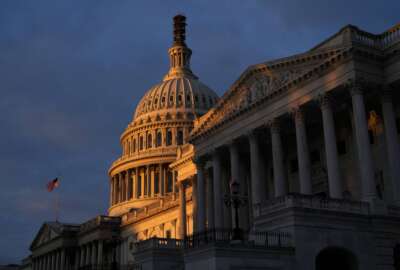

Deputy Secretary of Defense Robert Work says the Pentagon is making plans in case Congress cannot reach a budget deal or continuing resolution before Sept. 30.
As the likelihood of another government shutdown grows toward the end of September, the Department of Defense is prepping contingency plans for what will stay open in its wake.
In a letter released Friday, DoD’s Deputy Secretary of Defense Robert Work stated the department has updated its lists of essential employees and made preliminary determinations over what activities should continue running.
“As part of our effort to keep our personnel apprised of planning efforts, we are providing further information on how a potential government shutdown will affect our staff and operations,” Work stated in the letter. “Your chain of command will begin reaching out to you to provide additional detail on our contingency plans and your status under a potential lapse.”
While not an official notice of furlough, Work stated DoD employees should be prepared, and if they are furloughed, they will find out on Oct. 1.
DoD also released a contingency plan for the continuation of essential operations in case of a shutdown.
“All military personnel would continue in a normal duty status; however, they would not be paid until Congress provides funding.” the letter said.
According to Work’s letter, the attorney general and the Justice Department’s Office of Legal Counsel have the final say over who and what stops operating during a shutdown.
“Should a shutdown occur, and depending on the length of the shutdown, these determinations may change over time as circumstances evolve.” he said.
Work said a shutdown would hurt employees most of all.
“The uncertainty of the current circumstances puts our workforce in a difficult situation, and should the government shutdown occur, it could impose hardships on many employees as well as the people that we serve everyday,” he said.
Work’s letter is the latest in a series of warnings DoD has given about the potential damage a shutdown could do to its agencies.
The Obama administration has said it’s willing to work out a short-term continuing resolution in order to avoid a shutdown and keep DoD and priority missions from being underfunded.
In a press briefing on Sept. 24, press secretary Josh Earnest said while it may not be perfect for either party, a bipartisan continuing resolution would give Congress enough time to sort out final funding details.
“What we’d be willing to do is to join Democrats and Republicans on Capitol Hill in support of a piece of legislation that would prevent a government shutdown while also providing Congress enough time to work in bipartisan fashion to reach the kind of an agreement that ensures adequate funding for both our economic and our national security priorities,” he said.
Yet, DoD is wary of anything past a short-term CR, since extended time without an established budget would hamper modernization plans.
“The President asked for a $38 billion increase in Defense resources in 2016 over what we had in 2015. A CR gives us none of that,”said Jamie Morin, the director of the Cost Assessment and Program Evaluation (CAPE). “Those additive resources were overwhelmingly focused in getting our modernization back on track.”
Modernization previously bore the burden of sequestration cuts in DoD because personnel forces cannot be quickly and radically changed, and the cost to maintain the force has limited wiggle room.
Work stated in his letter Congress can work together to pass a CR before Sept. 30, but DoD won’t take any chances just in case.
“There is more than enough time for Congress to prevent this from happening,” Work stated. “However, prudent management requires that we continue to prepare for all contingencies, including the possibility that a government shutdown could occur at the end of the month.”
The contingency plan states that all military personnel on active duty will continue their assigned duties. Additionally, active duty personnel may be assigned to carry out furloughed civilian tasks as long as they do not incur new obligations.
Contractors performing under a fully funded contract that was awarded before funds run out will continue to provide services. However, new contracts and contract renewals may not be executed.
The contingency plan also notes what DoD civilian personnel will be designated as essential and still perform their duties in the case of a shutdown.
Essential personnel include fire protection, security, law enforcement, counterterrorism and terrorism intelligence positions. Emergency counseling services and inpatient medical staff will be working as well.
Contracting, contracting administration, contract payment and logistic operations in support of essential activities will not be furloughed. Activities necessary to control funds or new obligations incurred during essential activities will also be working during a shutdown.
Furthermore, any activities funded by a Defense working capital fund or revolving fund with positive cash values may continue until the cash runs out.
Copyright © 2025 Federal News Network. All rights reserved. This website is not intended for users located within the European Economic Area.

